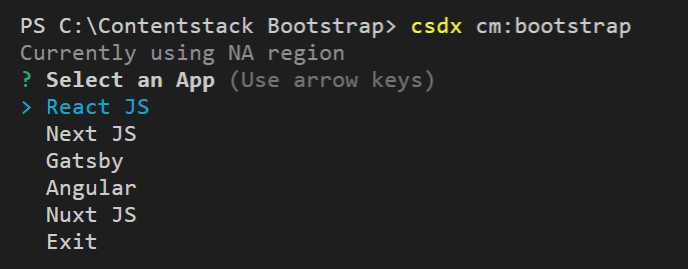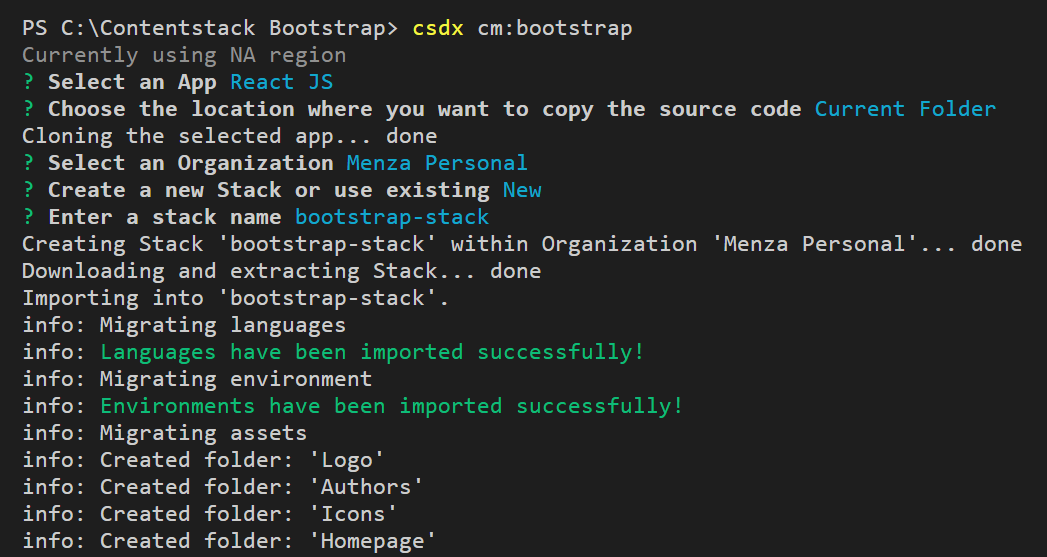Bootstrap Starter Apps | Old Commands
The “Bootstrap” plugin in Contentstack CLI allows users to automate the process of project setup for starter apps.
Using the CLI “Bootstrap” plugin developers can set up projects quickly and effectively. The plugin automates the whole procedure of stack creation and setting up the project.
Using this plugin, the content types, environments, entries, and assets required to run the starter apps get created in the stack you select or create.
In this guide, we will discuss how to use this plugin and automate the process.
Prerequisites
- Contentstack account
- Node.js version 16 or above
- CLI installed on your machine: npm install -g @contentstack/cli
Steps for Execution
Log in to Contentstack CLI session
If you haven't installed the Contentstack CLI yet, follow the steps mentioned in the CLI installation guide and get it installed.
After you have successfully installed the CLI on your machine, you have to log in to the CLI session to run the ‘Bootstrap’ command.
Note: By default, this CLI session will work for the app hosted in the North America region. If you want to switch to Europe or Azure North America region, follow the steps mentioned in the Set Region command section.
Now, open your terminal (command prompt) and run the following command to log in to your Contentstack account:
csdx auth:loginProvide your Contentstack account’s email and password to successfully log in to the CLI session.
Additional Resources: To learn more about the CLI login command, refer to the Login command section.
Use the Bootstrap command
After successfully logging in to Contentstack CLI, run the following command to initiate the procedure:
csdx cm:bootstrapThis command will prompt you to enter the following details:
- Technology
- Path
- Organization name
- Stack preference
Let's discuss these options in detail.
- Technology: Select the starter app (the technology type, such as React, Next, and so on) that you want to clone from the GitHub repository, from the available options.
For our example let's select React JS app.
- Path: Once you have selected the app, provide the folder path to copy the app's source code.
According to your preference, provide the folder path by selecting the Other option or you can use the Current directory as a default option.
This will start cloning the selected app to the folder you provide.
- Organization name: Now, Select an Organization from the list of your organizations.
The cloned app content will be added to a stack in the organization you select.
- Stack preference: In the organization you picked above, select if you want to create a new stack or use an existing stack to import the content of the app.
For this example let's create a new stack in the organization we selected.
- Accordingly, add the Name of the Stack where you want to import the project content and click the Enter button to start importing the project to the stack.

- On providing the above details, the plugin will add the project content including fields, and assets. It will also set up the environments, languages, and other settings for the selected app.
Note: Imported content will be automatically published in the target stack.
This is how you can automate the process of project creation in Contentstack by using the Bootstrap command.
The alternate way of using the plugin is by providing the required parameters after the command in a single line as shown below:
csdx cm:bootstrap -s <starterapp> -t <optional github private repo token> -a <app name> -d "<path or the location of the folder to clone the app>"Options:
- -t, --accessToken=accessToken: (optional) The token of your private repo to access the project.
- -s, --appType=appType: Sample or Starter app
- -a, --appName=appName: The app name of the starter app.
For eg. reactjs-starter, nextjs-starter, gatsby-starter, angular-starter, nuxt-starter. - -d, --directory=directory: Specify the path or the location of the folder to clone the app.
Examples:
- To select the app you want to clone, use this command:
csdx cm:bootstrap -a <app name>For Eg. To clone content of a React JS app:
csdx cm:bootstrap -a reactjs-starter - This is an optional command to be used if you want to clone a project from a private GitHub repository.
Provide the token of the private repository.
csdx cm:bootstrap -t <github private repo token> - Use this command to provide the path to the location of the folder to clone the app:For Eg.
csdx cm:bootstrap -d "<The path or the location to clone the app>"csdx cm:bootstrap -d "C:\Users\Name\Desktop\cli\content"
The above command will add the starter app’s (React JS) content to your stack as shown below:

Run the Starter Apps
You can easily run this starter app on your local machine by following the steps below:
Build, Configure and Run the Website (Manual Process)
Download the website code from our GitHub repository.
After downloading the website code, navigate to the root folder and create a configuration file named .env.development.,
Provide your stack credentials like API key, Delivery token, and environment:
REACT_APP_CONTENTSTACK_API_KEY = <api_key_of_your_stack> REACT_APP_CONTENTSTACK_DELIVERY_TOKEN = <delivery_token_of_the_environment> REACT_APP_CONTENTSTACK_ENVIRONMENT = <environment_name> REACT_APP_CONTENTSTACK_LIVE_PREVIEW= trueNote: By default, the Live Preview feature is disabled for this project. To enable it, set REACT_APP_CONTENTSTACK_LIVE_PREVIEW= true.
Now, fire up your terminal, point it to your project location, and run the following commands:
That’s it!npm install npm start
You can now view the website at http://localhost:3000.
Here's how your website's Home page will look after running on your localhost.
Deploy the Website
The easiest and the quickest way to deploy the React JS starter website on production is to use Vercel.
You need a Vercel account before you start deploying.Note: During deployment, to use the European or Azure North American region, add an environment variable REACT_APP_CONTENTSTACK_REGION and set its value to eu or azure-na respectively.
The Bootstrap plugin supports the following starter apps.
Starter Apps
Additional Resource: To create and run a demo website, use the sample code and guide provided in the Contentstack starter apps documentation.
Limitations:





.svg?format=pjpg&auto=webp)
.svg?format=pjpg&auto=webp)
.png?format=pjpg&auto=webp)






.png?format=pjpg&auto=webp)